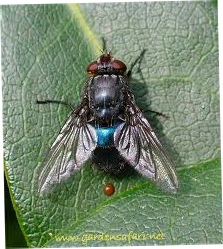
Tel No: 07769 620549
Flies
Blue bottle
Appearance: Shiny, metallic blue or green; 1/4-
Habitat: Bottle flies are one of the first insects to reach a dead animal, and the sudden appearance of dozens of them within a building signals a dead rodent, bird or other animal in the wall, ceiling, attic or crawl space. They breed in garbage containers, dumpster's and decaying vegetative matter. They are attracted to buildings by food odours and also warm or cool air currents coming through cracks around doors and windows.
Diet: Like all flies, bottle flies feed on a variety of food materials but prefer fermenting or decaying organic matter.
Insect control: Fly control is challenging because their larval sites must be located
and eliminated for success, and these sites may be some distance from where the adults
are a nuisance. Throw trash away in trash cans in plastic bags, and locate trash
receptacles as far from the building as possible. Keep doors and windows closed unless
they are equipped with a tight-
House fly
Appearance: Usually grey, with four black stripes on their backs; less than 1/4-
Habitat: As their name implies, house flies are the most common type found in homes.
They lay their eggs in almost any warm, moist material that will supply suitable
food for the larvae. House flies excrete and regurgitate whenever they come to rest.
This habit, combined with their many body hairs and the sticky pads on their legs,
makes them well adapted for transporting disease organisms.
Diet: Wide variety of food, including human food, animal food and carcasses, garbage and excrement.
Insect control: To minimize problems with flies, eliminate their breeding sites by
throwing away trash in plastic bags. Let trash cans dry out, and keep them as far
from your home as possible. Regularly pick up pet waste. For commercial establishments,
professional cleaning of dumpster's and nearby areas may be necessary.
Equip all doors
and windows with tight-
Bed bug
Appearance: Mahogany to rusty brown; red after a blood meal. Flat and oval, 1/4-
Habitat: As their name implies, bedbugs like to live and feed in beds. They can also live behind baseboards, wallpaper, upholstery and in furniture crevices. They like to travel and will hide in suitcases, boxes and shoes. Elusive and nocturnal, they make their presence known most often through the red, itchy bites they leave behind. They do not transmit diseases.
Diet: Primarily humans, although bedbugs can dine on any warm-
Insect control: Vacuum suitcases after returning from a vacation. Check bed sheets
for tell-
If you're having a bed bug
problem call WTC pest control. Serving the Devon area and surrounding suburbs.
Common flea
Appearance: Tiny, about 1/6-
Habitat: Fleas live on the bodies or animals and feed on their blood. Because fleas usually feed and lay their eggs while an animal is sleeping, your pet’s resting area is where the most fleas will be found. Many pets acquire fleas outside in the yard. The cat flea will attack both cats and dogs. Its flat shape allows it to pass easily between animal hairs.
Diet: Larvae feed on organic debris, particularly the faeces of adult fleas, which contain undigested blood. Females need to feed on animal blood in order to produce eggs.
Insect control: Controlling a flea infestation requires treating your pets, the inside of your home, and flea activity sites outside. To treat pets, consult your veterinarian and follow the instructions of recommended flea control products. To treat inside your home, remove all items from the floors and vacuum, wash and/or mop thoroughly. Wash or replace pet bedding. In homes with active flea infestation, professional treatment is advised. Because flea pupae are not affected by treatment, it may take up to two weeks after treatment before fleas are no longer seen.

WTC Pest Control
WTC Pest Control works in the Leek, Cheadle Stoke on Trent, Biddulph, Stafford, Sandbach, Stone, Eccleshall, Newcastle Under Lyme, Uttoxeter, Macclesfield, Congleton areas.
| Moles |
| Wasps |
| Mice |
| Ants |
| Cockroach |
| Rats |
| Flies |
| Squirrels |
| Pigeons |
| Seagulls |
| Bees |
| Moths |
| Moles |
| Wasps |
| Mice |
| Ants |
| Cockroach |
| Rats |
| Flies |
| Squirrels |
| Pigeons |
| Seagulls |
| Bees |
| Moths |